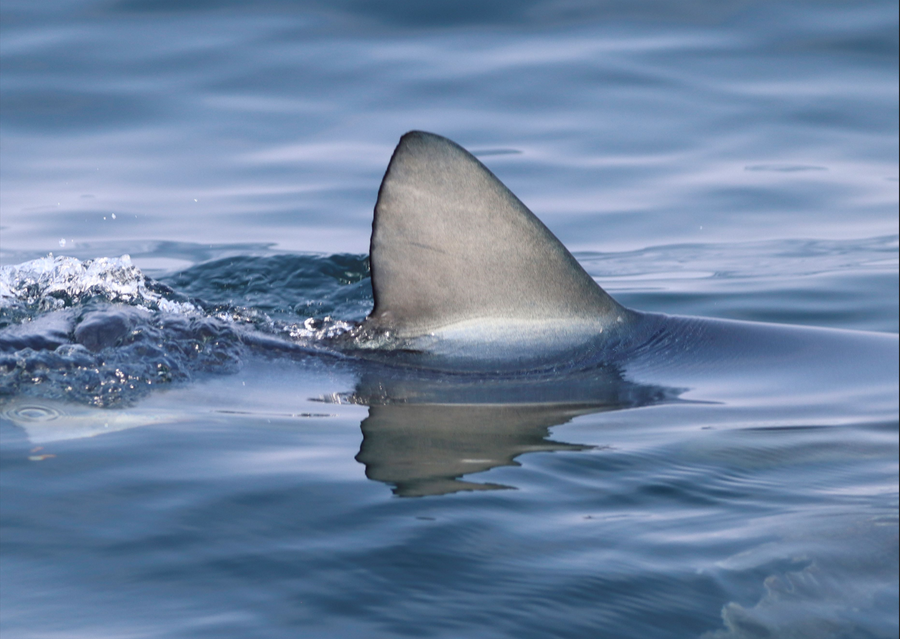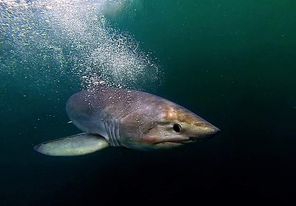Conservation with teeth: working with Anglers for a better future for sharks

Figure 1. The dorsal fin of the blue shark (Prionace glauca) as she cuts through the chum trail, 20 nautical miles south of Looe, Cornwall
The sea lies still, the white horses are still in bed, and the only signs of life are the storm petrels flicking off the chum slick and the occasional bickering of squabbling fulmars. Then, I catch the first glimpse of a white belly rolling near a float supporting a tempting mackerel supper. Was I imagining it? Suddenly, the shark's presence is confirmed by the tip of a dorsal fin half-sighted in the slick. She, for it was she, showed her presence many times as she traced the boundary of the scent trail back to its source. Soon, the anxious scream of a ratchet on a reel signals our first blue shark of the season, a fish that has crossed oceans to get here.
The oceanic waters off the coast of South West England are a seasonal home to several majestic shark species. Among them, the blue shark (Prionace glauca), with its mesmerizing azure-blue hue, is a summer visitor that may traverse the entire Atlantic in a year. The porbeagle (Lamna nasus) is a belligerent apex predator (Fig. 1), often mistaken for its more fearsome cousin, the great white shark (Carcharodon carcharias), despite its wary nature. Then there's the common thresher (Alopias vulpinus), a sight to behold with its vivid copper and purple hues and an extended lobe of the caudal (tail) fin, often as long as its body.
Many are surprised that despite the global decline of large pelagic elasmobranchs, these species have experienced a remarkable resurgence in the western English Channel over the past decade. From a bleak period at the turn of the millennium, when these iconic predators seemed destined to become a distant memory in our waters, we now find ourselves in a situation where the numbers of these fish may even rival the days in the early post-war years when sharks had little or no commercial value. The only exception to this trend is the shortfin mako (Isurus oxyrinchus), whose tragic decline due to overfishing has depleted the stock in the North Atlantic.
How do we quantify changes in shark numbers in our waters over time when commercial landings are rare, and bycatch is often unreported? The answer is data from recreational angling, specifically those provided to the Pat Smith Database (PSD) and those from the Shark Angling Club of Great Britain (SACGB)—see Box.

Figure 2. A large female porbeagle (Lamna nasus) captured on camera in the Celtic Deels.
The Shark Angling Club of Great Britain
The SACGB has an interesting history, formed in Looe on 4 January, 1953 by John Alan Lyde Caunter CBE, MC & Bar (1889–1981), a Brigadier in the British Army and a veteran of both world wars. He encountered large numbers of blue sharks whilst hunting for Atlantic bluefin tuna (Thunnus thynnus) in the waters off south-east Cornwall.
The SACGB realized the importance of angling to shark science and the club initiated its long association with scientists. As Brigadier Caunter noted in his 1961 book, Shark Angling in Great Britain, early collaborative tagging existed between the club and the then Ministry of Agriculture, Fisheries and Food (MAFF). The SACGB is still actively involved in tagging studies through the US National Oceanic and Atmospheric Administration’s (NOAA) Cooperative Shark Tagging program (CSTP), which has tagged over 295,000 sharks globally since its inception in 1962. NOAA actively encourages citizen science and the resulting programs produce both an excellent data set and a sense of involvement for anglers with fisheries management.
![figure_3[1]TMB July shark data.png](https://mymba.mba.ac.uk/static/daa2cfb3-9487-47bb-b12d119ae985fd5b/510x435_highestperformance__4a7c7e45a350/figure31TMB-July-shark-data.png)
Figure 3. Captures of four shark species from UK waters by recreational anglers since 1953. A: catch per unit effort (sharks per trip) of blue sharks. B. Annual captures of porbeagle sharks. C. Annual captures of common thresher sharks. D. Annual captures of shortfin mako sharks. Data from the SACGB and PSD.
You may question the ethics of recreational catch-and release angling for sharks in the UK. To some, the idea of putting a hook into a fish is unacceptable. Exceptional survival rates have been shown for blue sharks captured by anglers in the UK in a recent study, showing the value of the high standard of welfare adopted by anglers which has been promoted by groups such as, the SACGB, PSD, and the Angling Trust. And the fact remains that these data provide an unrivalled insight into the numbers and variety of large pelagic sharks in the UK since the founding of the SACGB in 1953. These data have formed the basis for an increasing number of scientific papers and are now the official data supplied by the UK to the International Commission for the Conservation of Atlantic Tunas (ICCAT) as blue shark captures in the UK.
These records now exceed 112,000 blue shark captures, 1,300 porbeagles, 200 common thresher sharks and 96 shortfin mako sharks since 1953. The data crucially have an effort component and include trips where no shark was captured, enabling modelling of catch per unit effort (CPUE) and demonstrating how an ever-changing environment can influence the numbers of these apex predators which reach UK waters each year.
The dataset was expanded in 2010 to include data from many other ports, from the Isle of Wight to Milford Haven, and now skippers and anglers provide their data freely to the PSD to help better understand shark ecology and the effects of commercial exploitation on shark numbers and movements within UK waters and beyond.
Figure 2 clearly shows that these iconic apex predators returned in large numbers to UK waters in the early to mid-2010s. Porbeagles, a species with no commercial catch allowed since 2010, reappeared in some places after an absence of over 30 years. Intriguingly, some of these fish were huge females over 20 years of age and would have predated the commercial restrictions. How these fish escaped intense commercial pressure for many years is a question as yet unanswered, but the presence of large numbers of recently born sharks in recent years off South West England indicates that this area could be a vital location for pupping.
So why did these species reappear in our waters, and is this a sign that shark populations which may have a North Atlantic distribution are in a healthier state than many fear?
Modelling of these data suggests that factors such as the Atlantic Multidecadal Oscillation (AMO) and salinity levels in the subpolar Arctic may contribute to changes in the position of the North Atlantic current, thus driving more blue sharks to our oceans during the summer months. Additionally, the decline of many mesopredators for whom the South West Approaches are the southern edge of their geographical range, such as cod, ling, and pollack, corresponded with both a surge in apex predator numbers and in the numbers of pilchards (Sardina pilchardus) and anchovies (Engraulis encrasicolus), suggesting a role of climate change. However, ecology is a slippery beast, and many factors probably contribute to the changes we have seen in shark numbers in the UK during the last 15 years. We will continue to collaborate with ‘experts by experience’, otherwise known as shark anglers, in our aim to unravel these mysteries.
Whatever the cause, the return of these magnificent creatures is welcome, and that first glimpse of the tip of the dorsal fin of a blue shark each summer never ceases to amaze and excite.
• Simon Thomas (bluedogfishing.simon@aol.com), University of York
